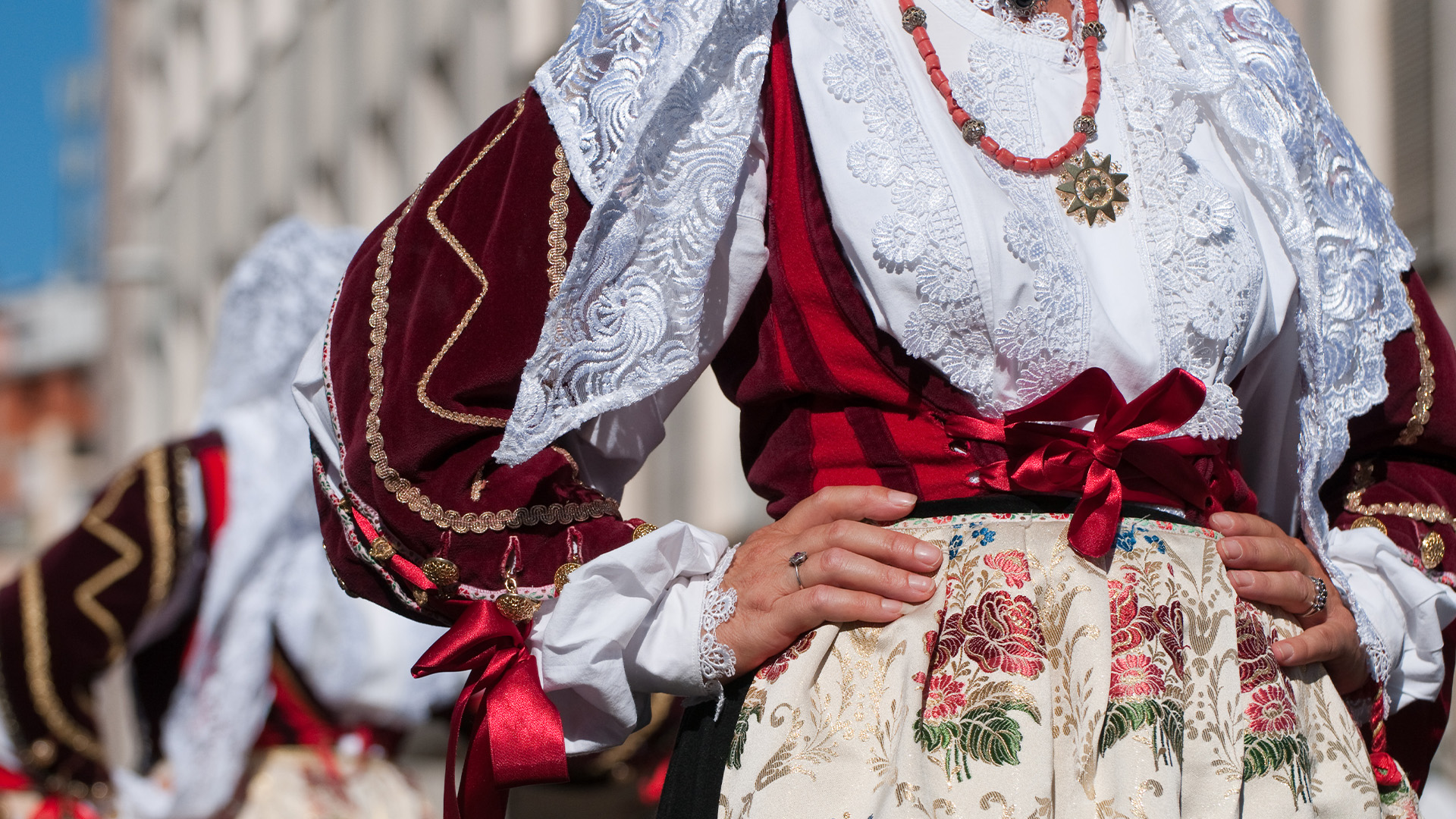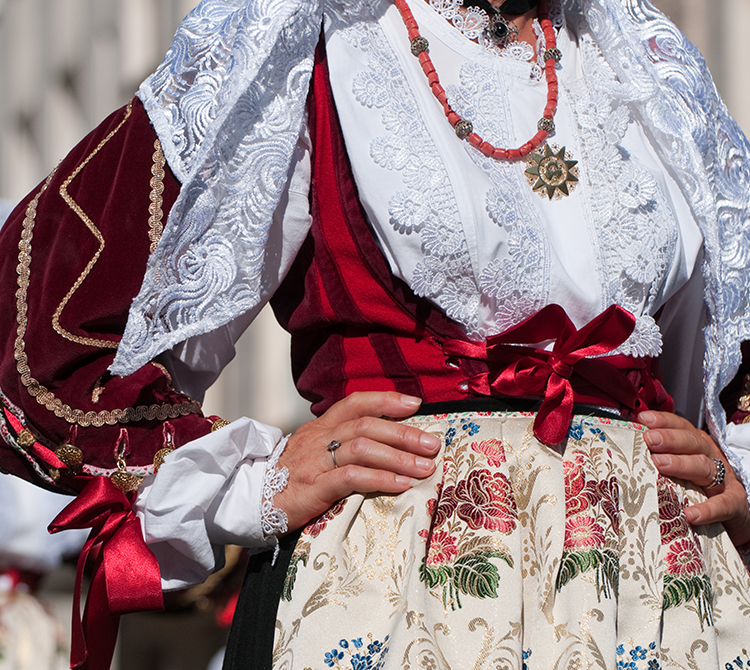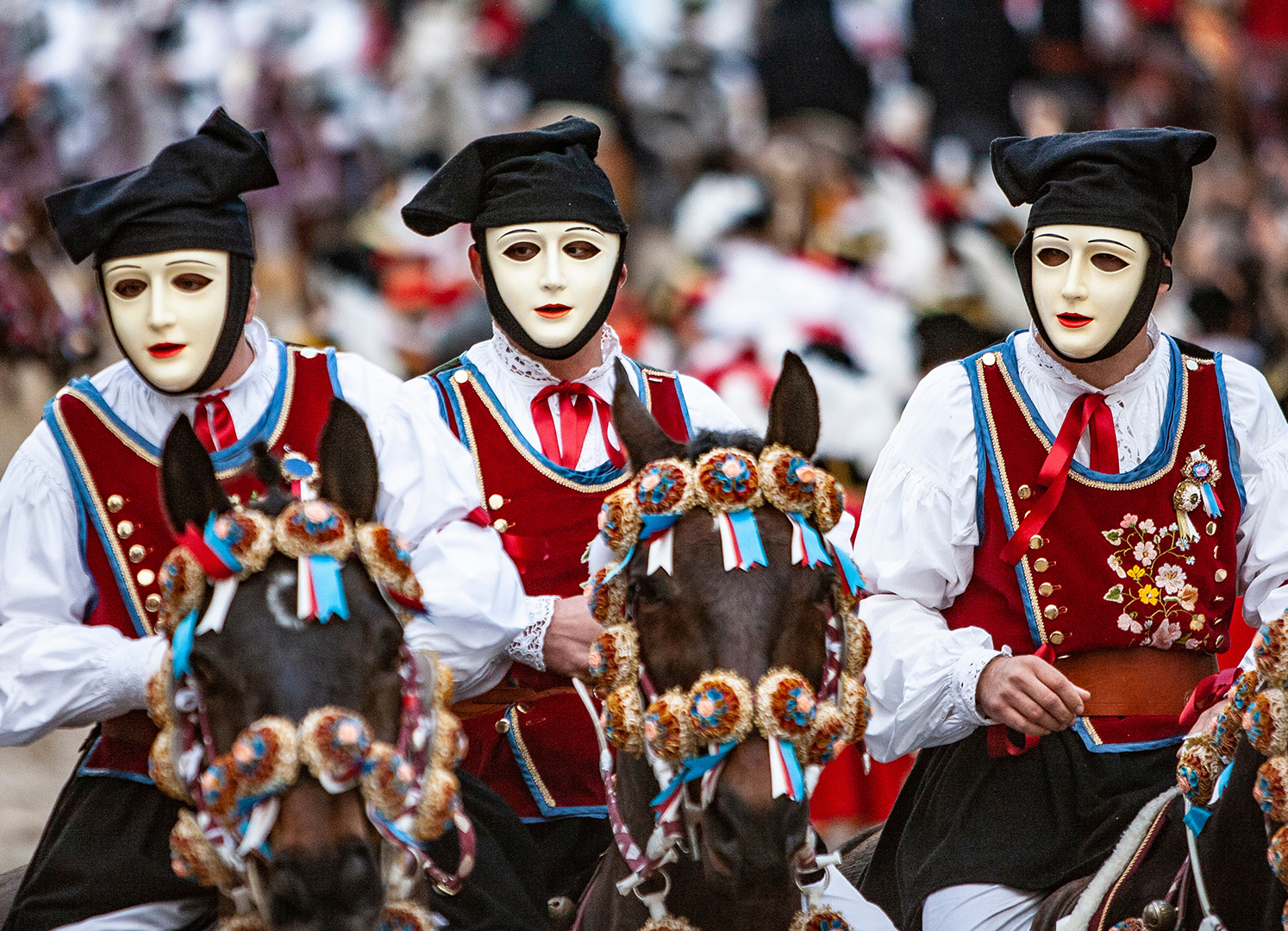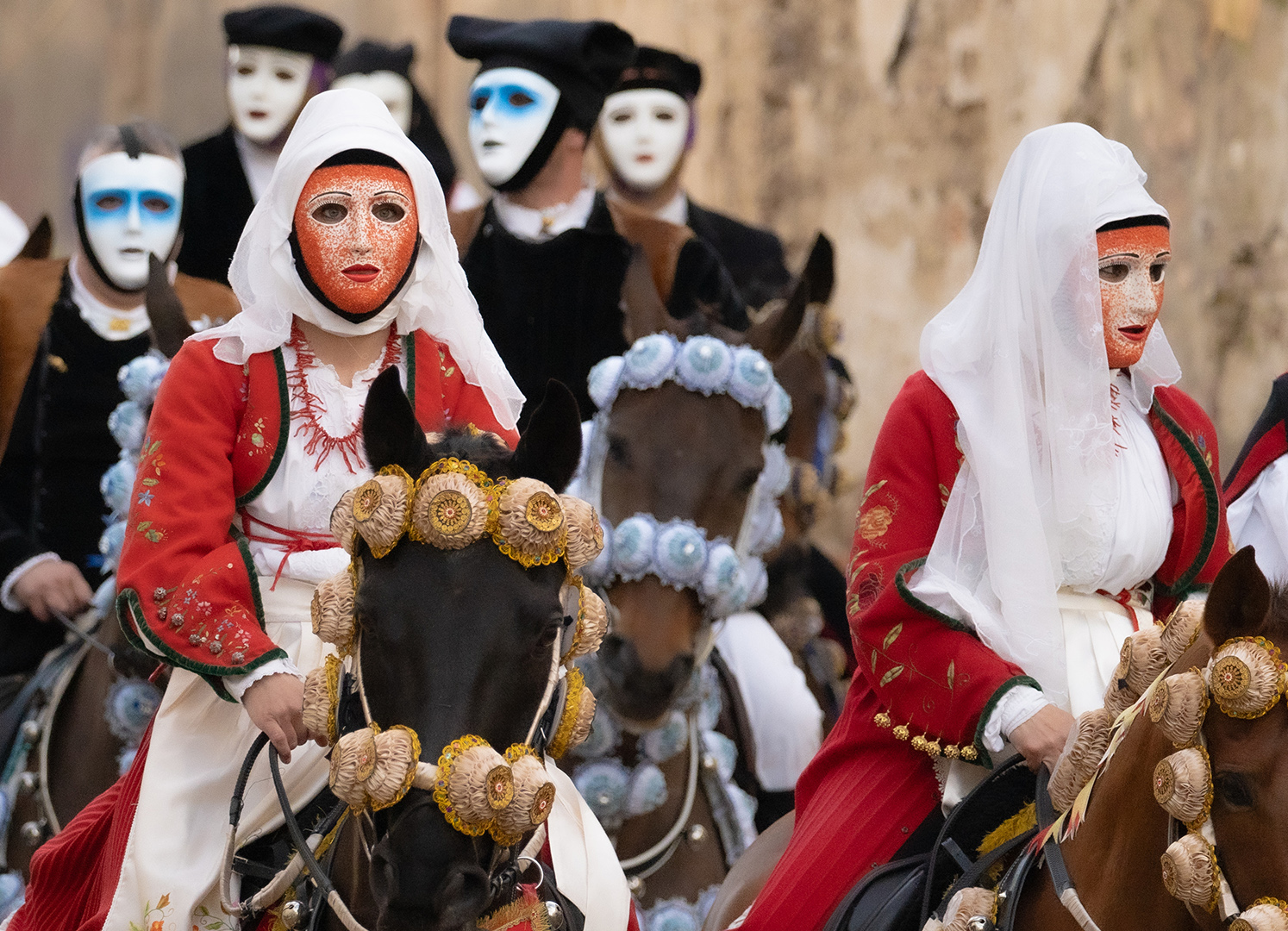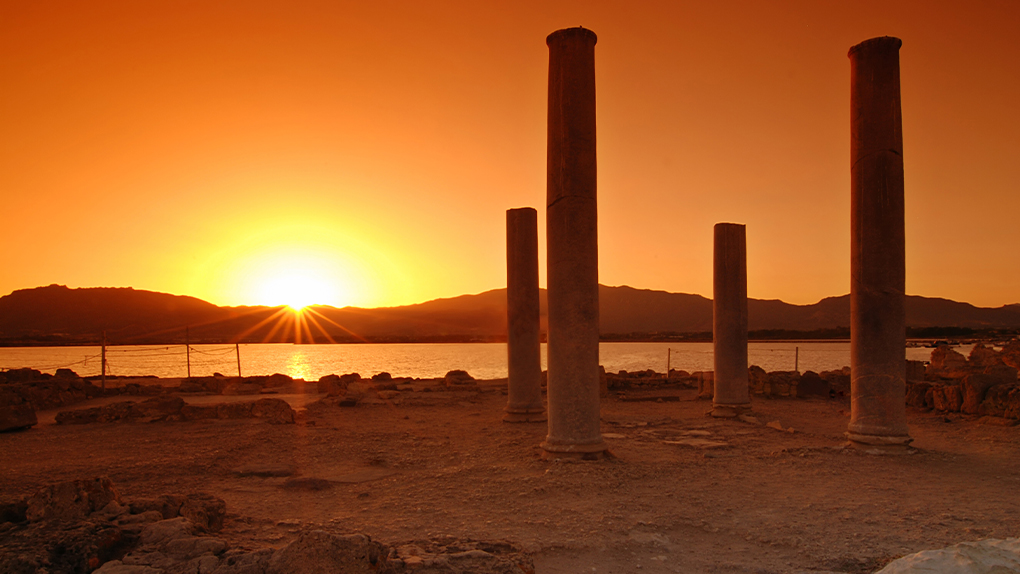Sardinia is more than just an enchanting island in the Mediterranean; it is a custodian of ancient traditions that seamlessly blend the past with the present. Every aspect of its culture reflects a deep appreciation for craftsmanship, authentic customs, and flavours that narrate a rich and varied culinary tale. This land, with its abundant cultural heritage, is beautifully showcased in Dolce&Gabbana’s Alta Moda, Alta Sartoria and Alta Gioielleria creations.
La Parata di Sant’Efisio
Among the celebrations that embody the soul of this land, the Sant’Efisio festival in Cagliari stands out as a gem of spirituality and tradition. From the 1st to the 4th of May, the city transforms into a stage of ritual and devotion. The saint, born in Antioch and revered for, according to legend, freeing the island from the plague in 1656, was martyred in Nora. His martyrdom is still honoured today with a solemn procession. The statue of Sant’Efisio, carried on a gilded cart and preceded by picturesque “traccas”—ox-drawn carts adorned with flowers and agricultural tools—travels through the city as hundreds of Sardinians, dressed in traditional attire, proudly showcase their identity and culture. One of the procession’s most poignant moments is the “Sa Ramadura” ritual, where the path, once lined with aromatic plants, is now adorned with flower petals. This creates a vibrant, fragrant carpet that beautifully commemorates the saint’s passage.
This celebration is not just a tribute to faith but a vivid expression of Sardinian identity and its deep roots.
Masks: mystery and magic
Carnival in Sardinia unfolds with myriad faces, each bearing unique significance and storied history, epitomised by the Mamuthones and Issohadores. Worn during the Mamoiada Carnival, these masks are living testimonies to a millennia-old cultural heritage. Meticulously handcrafted, they transcend mere festive attire to embody ancient traditions and symbols of communal identity.
The Mamuthones, adorned in dark wooden masks and sheepskin costumes, epitomize the enigmatic and sacred essence of the festivities. Their deliberate, solmn stride, accompanied by haunting chime of cowbells draped over their shoulders, evokes an ancient sense of mystery and ritual. These rhythmic movements, akin to a sacdred dance, carry an aura of reverence and awe, reminiscent of ancient propitiatory rites. Their presence symbolizes the raw force of anture and the ever-present uncertaintity of seasons, both integral and rural life in Sardinia.
The Issohadores, clad in white masks and colourful costumes, embody the vigour and dynamism of the age-old struggle between good and evil—a central theme in Sardinia’s traditional festivities. Their acrobatic feats and nimble movements, enhanced by the use of the “soha” (a rope symbolically capturing onlookers), evoke ancient bull hunts, revered as symbols of fertility and community renewal. Through their bold and dynamic performances, the Issohadores inspire vitality and optimism, celebrating the enduring strength and resilience of the Sardinian people.
Carried with reverence and respect, these masks are more than mere adornments; they are vessels of history, culture, and spirituality, linking past generations to the future while preserving Sardinia’s deep-rooted traditions and celebrating its rich cultural diversity.
Bread, a Culinary Treasure
Breadmaking is a sacred and ancient ritual passed down through the ages. This enduring tradition has elevated bread to a symbol of utmost importance in Sardinian cuisine.
The Coccoi Pintau, or “decorated bread,” with its distinctive shapes and delicate designs, is more than mere food; it’s an edible artwork. Crafted from robust dough and adorned by hand using traditional tools like knives and rollers, it stands as a custodian of ancient culinary traditions. Each piece is uniquely crafted and often served during festivities and ceremonies, such as weddings and baptisms, where its presence symbolizes prosperity and abundance, making every event a memorable experience.
On the other hand, the Carasau, also known as “music bread,” is as thin and crisp as a leaf. Originating from the central-western part of the island, this bread has won hearts with its versatility and distinctive flavour. Traditionally baked twice for extra crunch, Carasau is perfect on its own or paired with seafood, cheeses, and cured meats.
Each dish represents a unique culinary journey, an irresistible invitation to delve into the gastronomic traditions of an island that continues to enchant with its rich culinary heritage.
Ancient Traditions
Sardinia’s artisanal legacy is a rich tapestry of ancient traditions and evocative tales. Hand-woven carpets, intricately adorned with floral motifs, offer a glimpse into ancient narratives passed down through generations.
Alongside them, the woven baskets of Oliena and Sinnai stand as testaments to rustic beauty and the enduring craftsmanship of natural materials, seamlessly blending practicality with artistic expression.
Sardinian Filigree, an enduring art form, showcases exquisite jewelry crafted in delicate gold or silver filigree—rings, bracelets, earrings, and pendants. Among its treasures is the golden button, often housing a precious gem. Beyond their ornamental role in ceremonial attire, these buttons symbolise fertility and prosperity, their rounded contours symbolically echoing the feminine form and underscoring Sardinia’s profound cultural and ritualistic ties.
Traditional garments, adorned with intricate embroidery and vibrant fabrics, embody the distinctive identities of Sardinia’s diverse communities. Each stitch narrates a story of cultural devotion and pride, preserving artisanal mastery through generations.
Each Sardinian handcrafted piece embodies a unique journey through the art that resonates with the heart and soul of the island.
Experience the essence of Dolce&Gabbana Alta Moda in Sardinia


